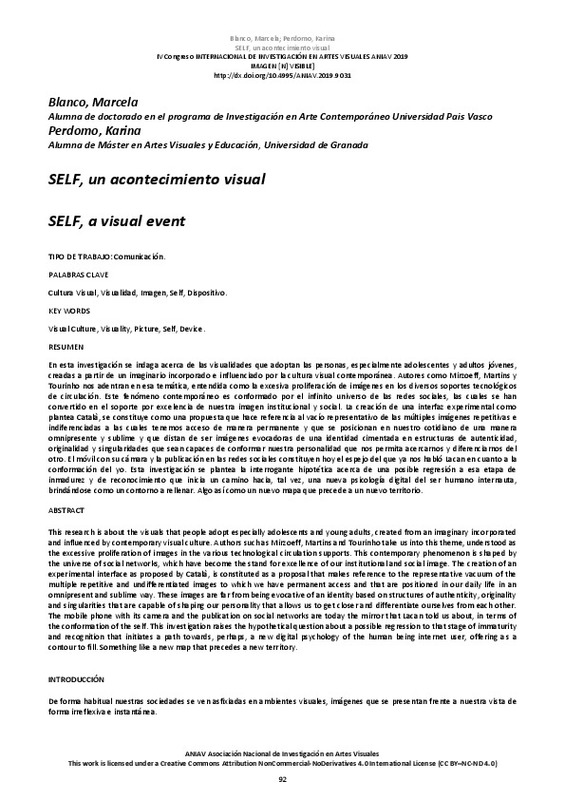JavaScript is disabled for your browser. Some features of this site may not work without it.
Buscar en RiuNet
Listar
Mi cuenta
Estadísticas
Ayuda RiuNet
Admin. UPV
SELF, un acontecimiento visual
Mostrar el registro sencillo del ítem
Ficheros en el ítem
| dc.contributor.author | Blanco, Marcela
|
es_ES |
| dc.contributor.author | Perdomo, Karina
|
es_ES |
| dc.date.accessioned | 2019-10-25T06:52:31Z | |
| dc.date.available | 2019-10-25T06:52:31Z | |
| dc.date.issued | 2019-09-10 | |
| dc.identifier.isbn | 9788490487662 | |
| dc.identifier.uri | http://hdl.handle.net/10251/129465 | |
| dc.description.abstract | [ES] En esta investigación se indaga acerca de las visualidades que adoptan las personas, especialmente adolescentes y adultos jóvenes, creadas a partir de un imaginario incorporado e influenciado por la cultura visual contemporánea. Autores como Mirzoeff, Martins y Tourinho nos adentran en esa temática, entendida como la excesiva proliferación de imágenes en los diversos soportes tecnológicos de circulación. Este fenómeno contemporáneo es conformado por el infinito universo de las redes sociales, las cuales se han convertido en el soporte por excelencia de nuestra imagen institucional y social. La creación de una interfaz experimental como plantea Català, se constituye como una propuesta que hace referencia al vacío representativo de las múltiples imágenes repetitivas e indiferenciadas a las cuales tenemos acceso de manera permanente y que se posicionan en nuestro cotidiano de una manera omnipresente y sublime y que distan de ser imágenes evocadoras de una identidad cimentada en estructuras de autenticidad, originalidad y singularidades que sean capaces de conformar nuestra personalidad que nos permita acercarnos y diferenciarnos del otro. El móvil con su cámara y la publicación en las redes sociales constituyen hoy el espejo del que ya nos habló Lacan en cuanto a la conformación del yo. Esta investigación se plantea la interrogante hipotética acerca de una posible regresión a esa etapa de inmadurez y de reconocimiento que inicia un camino hacia, tal vez, una nueva psicología digital del ser humano internauta, brindándose como un contorno a rellenar. Algo así como un nuevo mapa que precede a un nuevo territorio. | es_ES |
| dc.description.abstract | [EN] This research is about the visuals that people adopt especially adolescents and young adults, created from an imaginary incorporated and influenced by contemporary visual culture. Authors such as Mirzoeff, Martins and Tourinho take us into this theme, understood as the excessive proliferation of images in the various technological circulation supports. This contemporary phenomenon is shaped by the universe of social networks, which have become the stand for excellence of our institutional and social image. The creation of an experimental interface as proposed by Català, is constituted as a proposal that makes reference to the representative vacuum of the multiple repetitive and undifferentiated images to which we have permanent access and that are positioned in our daily life in an omnipresent and sublime way. These images are far from being evocative of an identity based on structures of authenticity, originality and singularities that are capable of shaping our personality that allows us to get closer and differentiate ourselves from each other. The mobile phone with its camera and the publication on social networks are today the mirror that Lacan told us about, in terms of the conformation of the self. This investigation raises the hypothetical question about a possible regression to that stage of immaturity and recognition that initiates a path towards, perhaps, a new digital psychology of the human being internet user, offering as a contour to fill. Something like a new map that precedes a new territory. | es_ES |
| dc.format.extent | 6 | es_ES |
| dc.language | Español | es_ES |
| dc.publisher | Editorial Universitat Politècnica de València | es_ES |
| dc.relation.ispartof | IV Congreso Internacional de investigación en artes visuales: ANIAV 2019 Imagen [N] visible | es_ES |
| dc.rights | Reconocimiento - No comercial - Sin obra derivada (by-nc-nd) | es_ES |
| dc.subject | Arte | es_ES |
| dc.subject | Producción artística | es_ES |
| dc.subject | Estética | es_ES |
| dc.subject | Teoría del arte | es_ES |
| dc.subject | Gestión cultural | es_ES |
| dc.subject | Educación artística | es_ES |
| dc.subject | Investigación artística | es_ES |
| dc.subject | Cultura visual | es_ES |
| dc.subject | Visualidad | es_ES |
| dc.subject | Imagen | es_ES |
| dc.subject | Self | es_ES |
| dc.subject | Dispositivo | es_ES |
| dc.title | SELF, un acontecimiento visual | es_ES |
| dc.title.alternative | SELF, a visual event | es_ES |
| dc.type | Capítulo de libro | es_ES |
| dc.type | Comunicación en congreso | es_ES |
| dc.identifier.doi | 10.4995/ANIAV.2019.2019.9031 | |
| dc.rights.accessRights | Abierto | es_ES |
| dc.description.bibliographicCitation | Blanco, M.; Perdomo, K. (2019). SELF, un acontecimiento visual. En IV Congreso Internacional de investigación en artes visuales: ANIAV 2019 Imagen [N] visible. Editorial Universitat Politècnica de València. 92-97. https://doi.org/10.4995/ANIAV.2019.2019.9031 | es_ES |
| dc.description.accrualMethod | OCS | es_ES |
| dc.relation.conferencename | IV Congreso Internacional de Investigación en Artes Visuales. ANIAV 2019. Imagen [N] Visible | es_ES |
| dc.relation.conferencedate | Julio 03-05, 2019 | es_ES |
| dc.relation.conferenceplace | Valencia, Spain | es_ES |
| dc.relation.publisherversion | http://ocs.editorial.upv.es/index.php/ANIAV/ANIAV2019/paper/view/9031 | es_ES |
| dc.description.upvformatpinicio | 92 | es_ES |
| dc.description.upvformatpfin | 97 | es_ES |
| dc.type.version | info:eu-repo/semantics/publishedVersion | es_ES |
| dc.relation.pasarela | OCS\9031 | es_ES |








